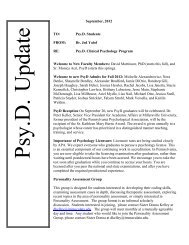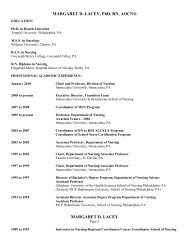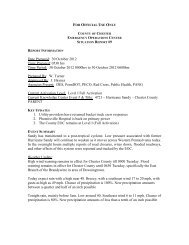Psy.D. Handbook Doctor of Psychology Program in Clinical ...
Psy.D. Handbook Doctor of Psychology Program in Clinical ...
Psy.D. Handbook Doctor of Psychology Program in Clinical ...
Create successful ePaper yourself
Turn your PDF publications into a flip-book with our unique Google optimized e-Paper software.
There will be test data that needs to be <strong>in</strong>tegrated <strong>in</strong>to the report. Po<strong>in</strong>ts will be<br />
assigned for each accurate representation <strong>of</strong> a data po<strong>in</strong>t. Po<strong>in</strong>ts will be assigned to<br />
diagnosis, recommendations, summary, and overall quality <strong>of</strong> written expression.<br />
IV. Cl<strong>in</strong>ical Case Evaluation: <strong>Psy</strong>chotherapy: Each student is assigned to two faculty members<br />
for the Cl<strong>in</strong>ical Case Evaluation. The Cl<strong>in</strong>ical Case Evaluation is scheduled for one hour.<br />
You must present either an audio-record<strong>in</strong>g <strong>of</strong> an <strong>in</strong>dividual psychotherapy session or<br />
three consecutive sessions <strong>of</strong> process (i.e., verbatim) record<strong>in</strong>g. Each faculty member will<br />
have access to the student’s psychotherapy tape and transcript, or process notes. Cases<br />
must come from practicum (PSYC 782-83; PSYC 695; PSYC 750-54, or PSYC 785, if<br />
required). Students must use the department’s Release for Audio Record<strong>in</strong>g Form<br />
(Appendix XIII) even if the practicum site has its own form. Submit both forms, if<br />
needed, but you must submit the department’s form if you are audio-record<strong>in</strong>g a s<strong>in</strong>gle<br />
session. If audio-record<strong>in</strong>g, use small tapes or CDs. Other methods must be approved by<br />
the chair. (Requests are made <strong>in</strong> writ<strong>in</strong>g, hard copy, signed, dated.) (not small tapes for<br />
m<strong>in</strong>i-recorders). Transcripts must be typed. Each exam<strong>in</strong>er gets one copy <strong>of</strong> the tape and<br />
one copy <strong>of</strong> the transcript, so please make duplicates. If you are us<strong>in</strong>g process notes, your<br />
supervisor must sign and date each <strong>of</strong> the three consecutive sessions to verify your work.<br />
Make duplicate copies for the exam<strong>in</strong>ers. You may br<strong>in</strong>g your own copy for reference<br />
dur<strong>in</strong>g the exam<strong>in</strong>ation.<br />
There are two parts to the psychotherapy evaluation.<br />
1. Case Presentation (Pass or Fail): The first part is devoted to summariz<strong>in</strong>g the case<br />
orally. You will be asked, “Please summarize your case.” Your summary should<br />
<strong>in</strong>clude reason for referral and relevant background and history, diagnosis,<br />
treatment plan, medication, general health status, type <strong>of</strong> therapy approach, and<br />
progress to date. The expectation is that students will be able to present a case <strong>in</strong> a<br />
format similar to the type <strong>of</strong> verbal case reports that are summarized concisely <strong>in</strong> a<br />
Case Conference <strong>of</strong> Grand Rounds proceed<strong>in</strong>g. There is no written component<br />
that accompanies the case. You are not permitted to read from notes. You may be<br />
asked a follow-up question (e.g., “How did you arrive at the diagnosis?”), but the<br />
goal is to limit this portion <strong>of</strong> the exam<strong>in</strong>ation to no more than 15-m<strong>in</strong>utes. An<br />
example <strong>of</strong> how students are expected to present their case is as follows.<br />
The patient is a 25-year-old Caucasian female, college educated, employed as<br />
a computer operator <strong>in</strong> a nationally-known firm with a history <strong>of</strong> Bulimia<br />
Nervosa who was referred to…facility because <strong>of</strong> depression, anxiety, and<br />
suicidal ideation follow<strong>in</strong>g the break-up <strong>of</strong> a two-year relationship with her<br />
boyfriend. The patient lives alone. Follow<strong>in</strong>g the break-up, she became<br />
depressed and began a b<strong>in</strong>ge-purge cycle. She was talk<strong>in</strong>g about suicide. Her<br />
friend came with her to the emergency room. They referred her here. She has<br />
never been hospitalized, but has had a few short-term therapies. She was kept<br />
overnight and then released. She was placed on Zol<strong>of</strong>t and referred for<br />
outpatient <strong>in</strong>dividual and group therapy. She has been see<strong>in</strong>g me weekly for<br />
three months. My approach to therapy is…Progress has been…<br />
Grad<strong>in</strong>g: This section is graded as Pass or Fail<br />
44

















